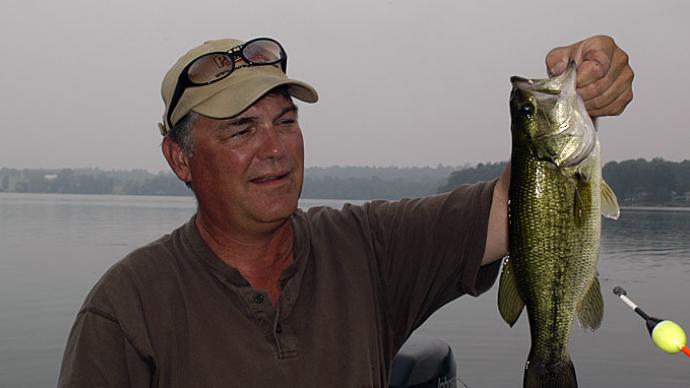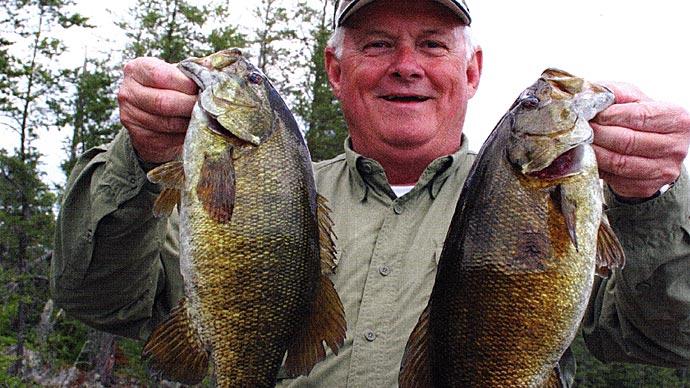
Adding a fly rod to your arsenal might not increase your catch ratio, but it sure will kick the fun factor up a notch. Getting started can be simple and easy. I have been chasing bass with a fly rod for a long time. I can help get a novice started down the right path and hopefully avoid some of the rookie mistakes I made. The basic outfit consists of the rod, reel, line, leader, and fly—a spool of tippet material and some line cleaner and dressing round out the package. Learning to cast a fly rod is relatively easy, much easier than mastering a baitcaster.
Rod selection should not be confusing; there is too much emphasis on rods' actions. The technology built into high-priced rods can be lost on the average caster. Fast action rods will allow the caster to throw tighter loops, increasing the casting distance, which may be a great attribute on a bonefish flat in the Keys but not so important when working lily pads from 40 feet. Slow, medium, or medium-fast rods allow the angler to feel the rod load and develop a cadence when casting. A 9-foot 8-weight or 9-weight rod is a good start for largemouth bass. Smallmouth in rivers or streams can be caught with smaller flies, so a 9-foot 6-weight or 7- 7-weight might be better. If you will chase both species, choose a rod that will cast the biggest fly you plan on using. It is much easier to cast a small fly with a heavy rod than a big fly with a light rod. Go to a good fly shop and cast different actions and price points. I recommend casting the rod with a line one size heavier than the rod is rated for to see how that feels. The rod that feels most comfortable to you would be my recommendation. Don't get caught up in the name game and buy more rod than you can afford. You will regret it in the long run. Learning how to use and enjoy a fly rod is much more important than the name on the rod. Once you have selected a rod, sign up for a casting clinic or find someone to get you started with the basics.
Fly reels for bass fishing don't have to be exotic. Again, don't get sucked into the high-priced works of art unless you plan on using the reel for multi-species. A smooth drag is essential to protect the leader, but in most cases, the fish will not be fought "on the reel." Stripping in the line easily lands them. There are good choices in the $30.00 to $40.00 range. Make sure extra spools are readily available and inexpensive. I try to have one reel size cover as many rods as possible. I use two identical reels, and with seven spools, I have five different rod sizes covered. That is a lot cheaper than buying a bunch of reels. If you decide on a 9-weight outfit, a reel rated for 7-8 lines will work fine. Reels rated for bigger line sizes start getting big and heavy to allow for increased backing capacity and bigger drags. I like to keep my outfits as light as possible.
There are many types of fly lines; for bass fishing, a weight-forward bass bug taper is a good start. Fly line is expensive but will last years with proper care. Line cleaner and dressing is inexpensive, and it will keep the line working like new. Also, to aid in casting performance, stretch the line before fishing. I pinch the line in my shirttail and pull it through; this will also clean it up if it wasn't cleaned the last time it was put away.
The weight rating of the fly line is based on the weight (in grains) of the first 30 feet of the line, which is called the head. The last 60 or 70 feet is a thinner diameter called the running line. A rod designed to throw an 8-weight line will be properly loaded with 30 feet of line in the air. I measure the distance from the tip of my rod to the front edge of my grip, for instance, 8 feet. Then, I measure the first 38 feet of my fly line and mark it with a permanent marker. I also tie a small nail knot at the spot to see and feel when I have 30 feet of line in front of me. Then, I can make my next cast and load the rod quickly. Sometimes, working with 30 feet of line in the water isn't practical, so to load the rod quicker, I will use a heavier line, for instance, a 9-weight line on an 8-weight rod. I will cast the rod with the heavier line, determine the point at which the rod loads comfortably, and then mark the line as described above. Most pros I have talked to about over lining the rod only recommend going up to two line sizes above the rod's rating. Naturally, using a lighter line will speed up the action of a rod. If you enjoy fly fishing, you should pick up a sink tip line to add depth to subsurface flies.
I also like to use the sink-tip line with diving flies. I don't recommend using full sinking lines to work deep water (over twelve feet). I suggest picking up the casting tackle. Some purists may disagree with me, but I lose contact with the fly using a full sinking line, and it is too easy to hook a fish deep. I practice catch and release. It is not worth catching a fish if I feel I will injure or kill it.
The line-to-leader connection can either be a nail knot or a loop connection. The loops add some bulk, but they don't affect casting; be careful to keep them outside the guides while fishing. I usually fish with short leaders in the six- to eight-foot range with 12- or 14-pound test tippets. There are good knotless leaders on the market. Pick up a spool of tippet material that matches the leader. The one thing to remember is that using a leader longer than the length of the rod will make it difficult to land a fish without getting the line/leader connection inside the guides. A break-off is almost certain if the connection is in the guides and the fish runs.
Flies can be alarmingly expensive; some are as much as a crankbait. A few topwater bugs and some streamers will be a good start. Most of my smallmouth flies are size 8 or 6, and my largemouth flies are size 4 to 2/0. For topwater flies, I suggest foam poppers and divers/sliders over deer hair. Deer hair will require dressing to stay floating all day, and a couple of good strikes can ruin the best-tied bug. For streamers, Clouser Minnows, Wooly Buggers, Muddler Minnows and Zonkers are all proven winners. Hare Grubs and Hare Jigs are good starters for working the bottom.
I strongly suggest bending down the barb on all flies. Eliminating the barb will make solid hooksets easier, and if someone gets hit with an errant fly, it will be much easier to remove. I want to pass on a few other safety tips: Always wear eye protection and know where the back cast is going. Only begin the back cast after looking over your shoulder. Fly-casting can draw a crowd, so don't be surprised by curious onlookers.
Once you start fishing and get your first strike, don't set the hook like you are holding your favorite worm rod. You'll pull the fly away from the fish. During the retrieve, keep the rod tip low to the water and point at the fly with no slack line on the water. When a fish strikes, pull the line with your line hand away from the rod while sweeping your rod in the opposite direction. You should be hooked up and positioned well to fight the fish. If a fish happens to bury in the weeds, keep sideways pressure on the fish, preferably in the direction you want the fish to go. Then, start tapping on the rod, which must irritate the fish because they almost always turn and swim toward the pressure.
Cruising the shallows and casting to likely spots or sight fishing can be a great use of the fly rod, but get the gear ready before fishing by stripping off the approximate amount of line needed, cast the line out, then strip it back in and coil it on the deck. Stripping the line off the reel and just coiling it on the deck will result in the line going to the reel on top of the line going to the rod, and there will be a big tangled mess on the first cast. To keep rods strung up and ready on the deck, run the line from the tip behind the reel back to the last stripping guide, and then hook your bug to the guide support. By doing this, you will be able to keep the line/leader connection out of the guides, and it will be much easier to get the rod in play when the time comes.
I hope this brief overview has been helpful, and if there are any questions, drop me (G3 Fan) a line in the forums. The most important thing is to get out there and try it.




